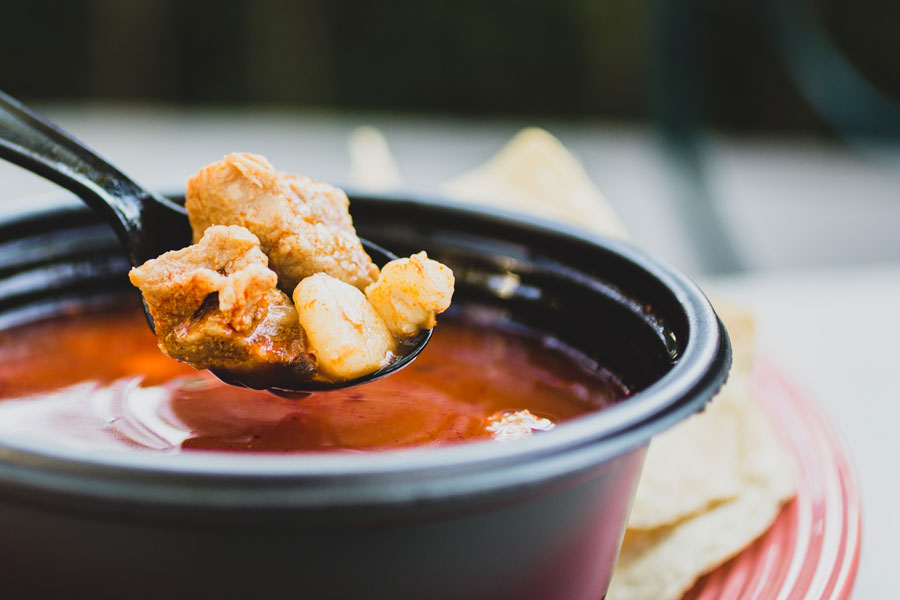Your Favorite Mexican Stew Has Cannibalistic Origins

When the holidays near, and Mexican families get ready to sit at the dinner table to slurp up their beloved pozole, there’s a good chance they have no idea about its documented dark past.
As a man who loves his pozole, and has eaten at least three bowls of it every Christmas Eve since he was 12, you can imagine my surprise in learning that the Mexican stew has a history of being made with human flesh.
The man-meat pozole tidbit was something that I stumbled upon while watching an episode of “Migrant Kitchen,” on KCET. This particular episode featured Mexican Chef Claudette Zepeda-Wilkins, whom I had recently interviewed, which led me to delving into more of her work.
In the episode, journalist Beto Lanz spoke about pozole pre-dating Hispanic cultures. Its original form used meat that were not only of rodents, which is cringeworthy in its own right. But even before that, there were rituals where the bodies of sacrificed men were used in the dish.
View this post on Instagram
Lanz went on to explain that when the Spaniards made their way to the Americas, they put an end to these types of sacrificial ceremonies.
My initial reaction while hearing all of this, was, ‘No waaaaaay!’ But then a few seconds later, I realized that it’s probably not something that’s too far-fetched.
I feel guilty being part of a Mexican-American generation that sometimes forgets to check in on the ol’ cultural roots, so the whole Aztec cannibalistic era was lost on me, as I’m sure it has been for many. So I dove into a little bit of food history to see what I’d find out about the classic native dish.
Obviously human sacrifice and cannibalism don’t necessarily go hand-in-hand, but there have been anthropological studies that linked Aztec sacrifices and the consumption of human meat.
A study at Michigan State University suggests that, “In addition to ‘merely’ sacrificing humans, it is generally accepted by anthropologists that the Aztecs also cannibalized these sacrificial offerings.”
So while the Aztecs didn’t just go around eating people left and right like in The Book of Eli, in certain situations, the consumption of human flesh did occur.
Those findings are pretty gruesome to think about, but can you really link that to our precious pozole? Here is why many believe you can.
View this post on Instagram
Additional academic findings bring us to Moctezuma. Yes, the dude from the Knott’s Berry Farm ride.
The Arizona Historical Society has documented that the ruler did have a bit of a taste for human flesh.
Writings from ethnologist Father Bernardino de Sahagun, show that Emperor Moctezuma had a grand feast that featured not just the familiar boiled corn, but human flesh, with the royal “having a whole thigh reserved for himself.”
The Aztec term for “pozol” meant “foamy,” which is why it is linked to the pozole we know today. As anyone who has cooked the dish, knows it gets frothy when the corn is being boiled.
While Sahagun never mentions pozole by name, he mentions that the Moctezuma’s feast consisted of tlacatlaolli, which isn’t exactly like the pozole we’re familiar with, but was a boiled corn dish that is linked to pozole origins.
So while it is not explicitly stated that “pozole” was a dish fit for cannibalistic appetites, there is some research that implies it.
Moctezuma fed human parts to his guests, who were probably thinking that dude was a psychopath, and forever sullied the precious origins of our beloved pozole.
While pozole literally translates to “hominy” and that corny portion of the ingredient list has stayed the same through time, it’s interesting to note that the meaty portions weren’t always the pig’s feet and pulled pork we’re used to.
Now, as you sit and eat your pozole, you can tell your grandma that pozole used to be made with human flesh, as she’ll promptly smack you for being gross at the dinner table.






















